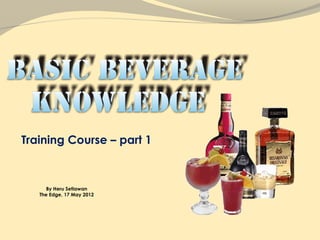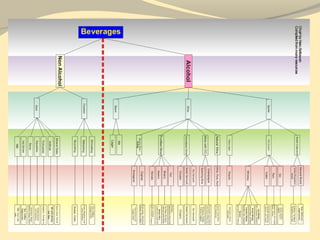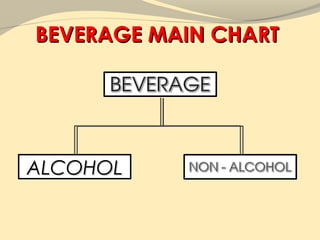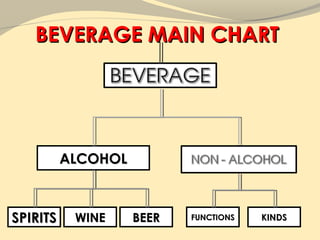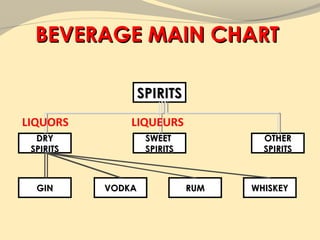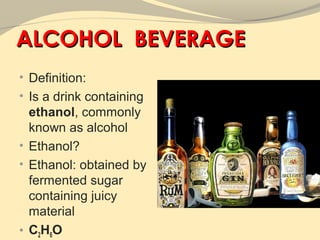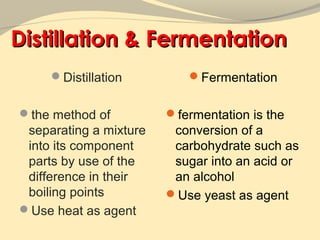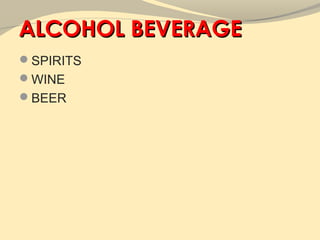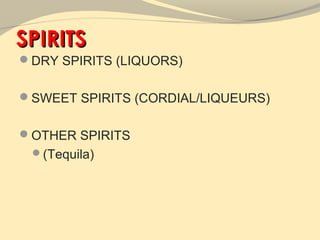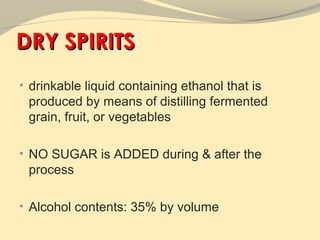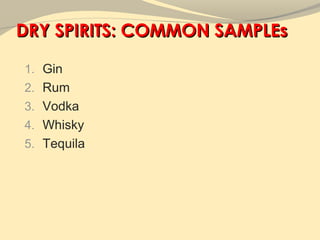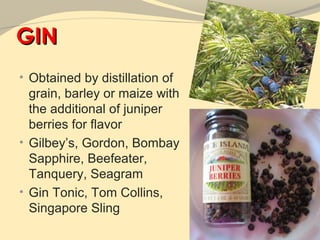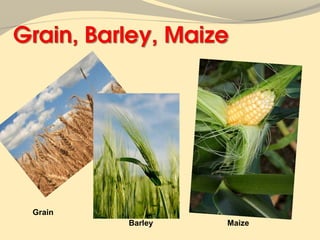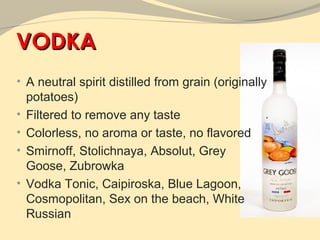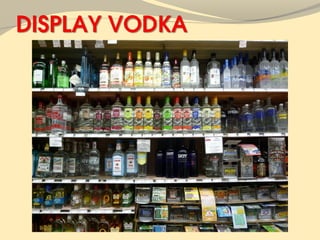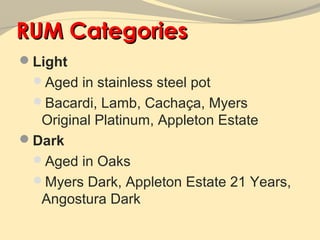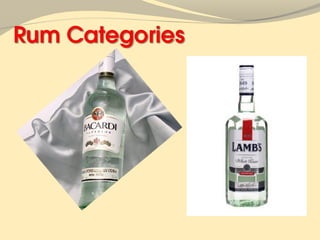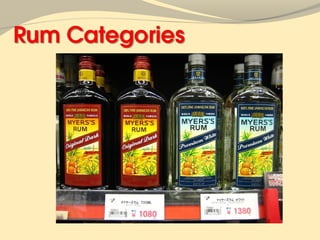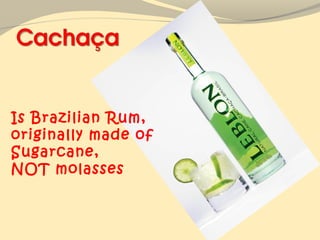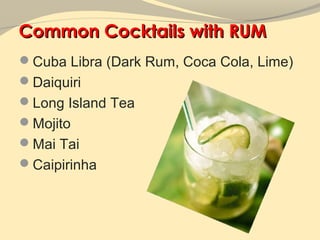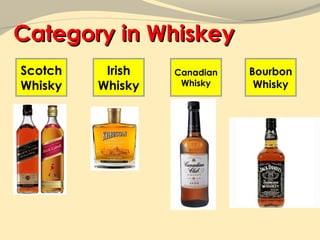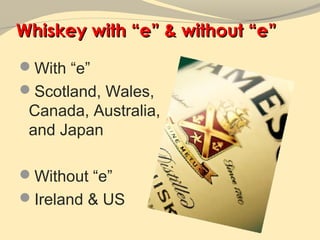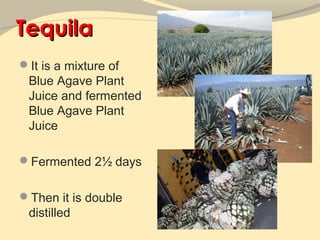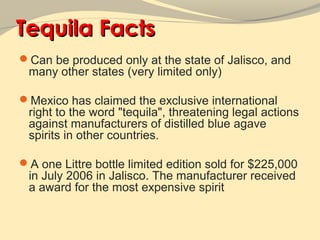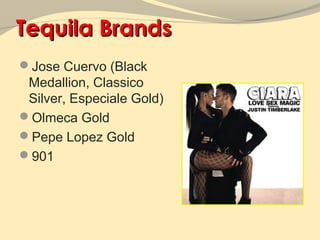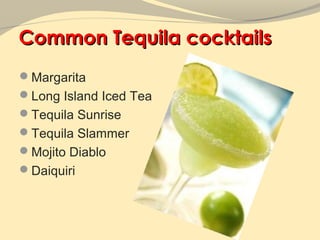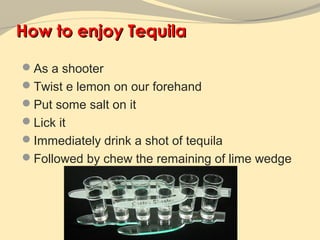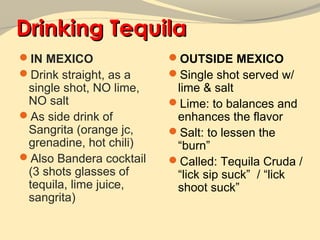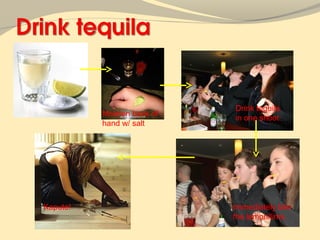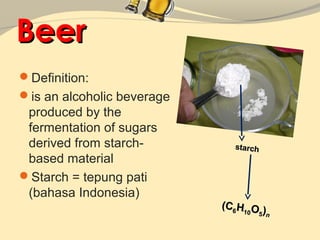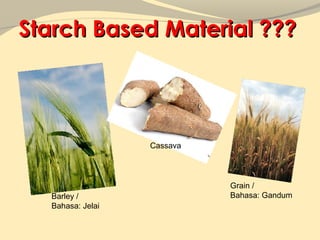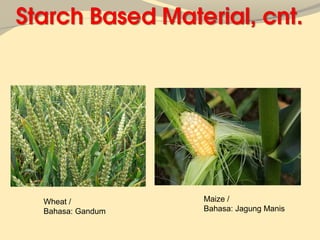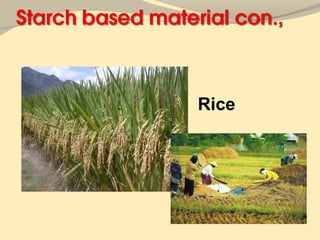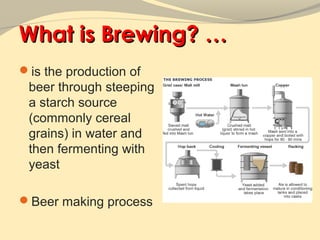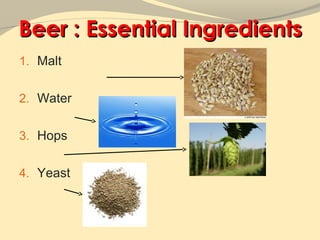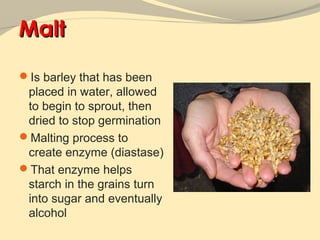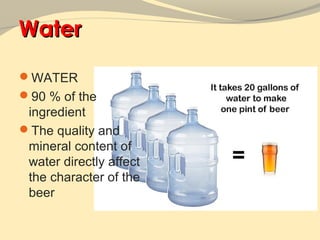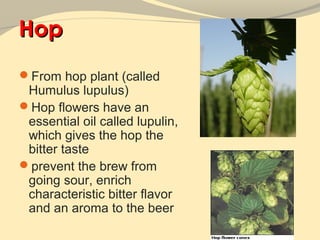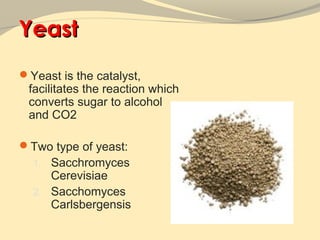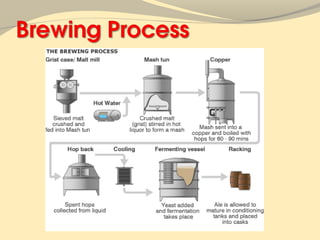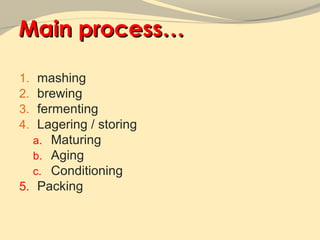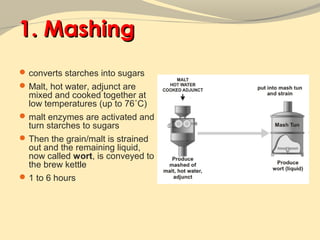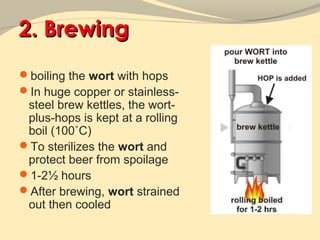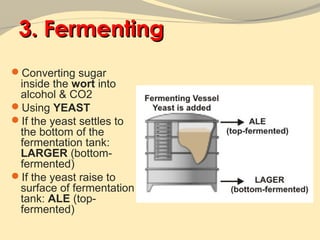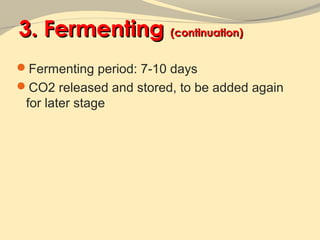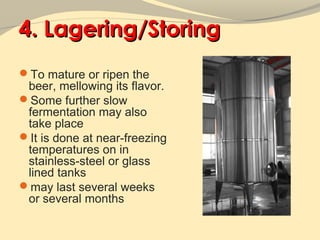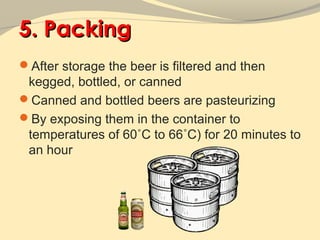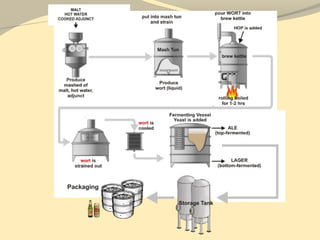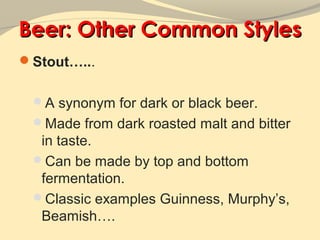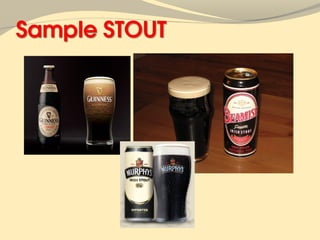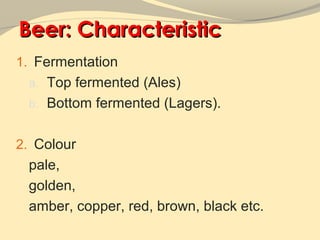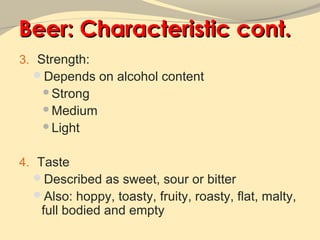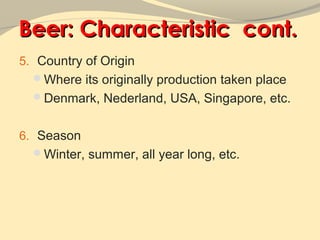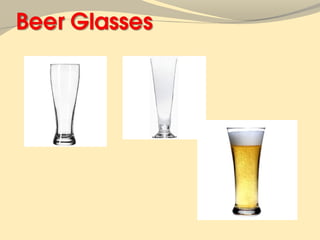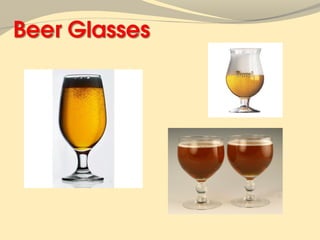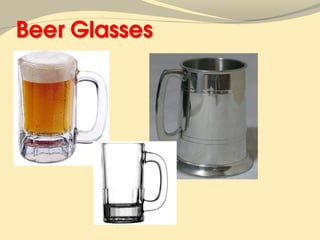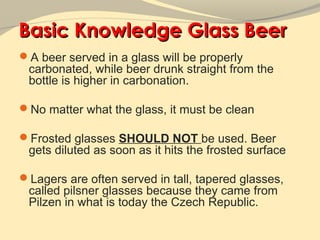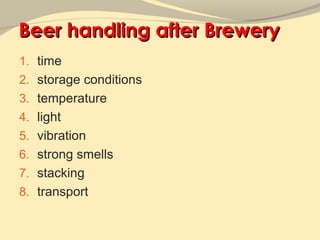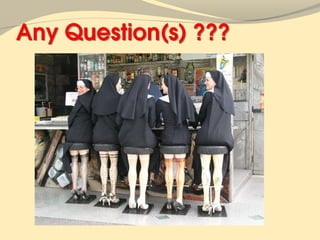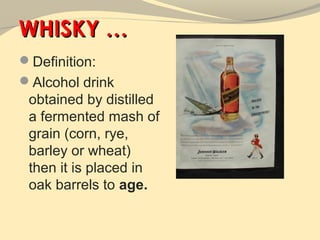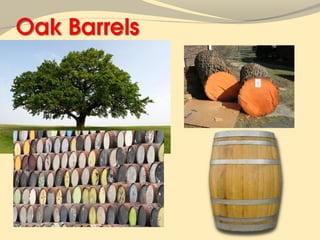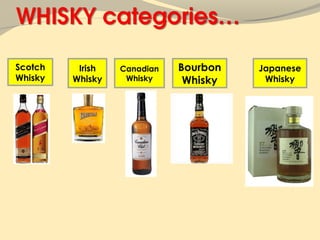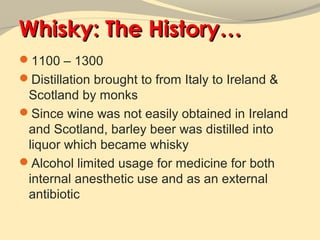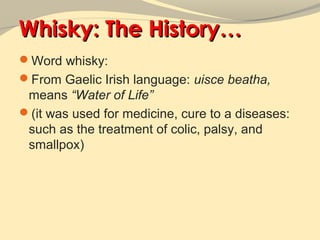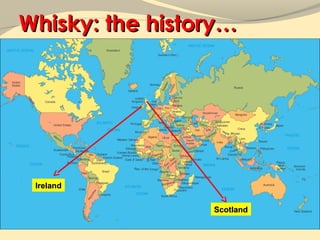Basic beverage knowledge heru
- 1. Training Course – part 1 By Heru Setiawan The Edge, 17 May 2012
- 4. BEVERAGE MAIN CHART ALCOHOL SPIRITS WINE BEER FUNCTIONS KINDS
- 5. BEVERAGE MAIN CHART SPIRITS LIQUORS LIQUEURS DRY SWEET OTHER SPIRITS SPIRITS SPIRITS GIN VODKA RUM WHISKEY
- 6. ALCOHOL BEVERAGE • Definition: • Is a drink containing ethanol, commonly known as alcohol • Ethanol? • Ethanol: obtained by fermented sugar containing juicy material • C2H6O
- 7. Distillation & Fermentation Distillation Fermentation the method of fermentation is the separating a mixture conversion of a into its component carbohydrate such as parts by use of the sugar into an acid or difference in their an alcohol boiling points Use yeast as agent Use heat as agent
- 8. Distillation & Fermentation DISTILLATIONS FERMENTATION
- 10. SPIRITS DRY SPIRITS (LIQUORS) SWEET SPIRITS (CORDIAL/LIQUEURS) OTHER SPIRITS (Tequila)
- 11. DRY SPIRITS • drinkable liquid containing ethanol that is produced by means of distilling fermented grain, fruit, or vegetables • NO SUGAR is ADDED during & after the process • Alcohol contents: 35% by volume
- 12. DRY SPIRITS: COMMON SAMPLEs 1. Gin 2. Rum 3. Vodka 4. Whisky 5. Tequila
- 13. GIN • Obtained by distillation of grain, barley or maize with the additional of juniper berries for flavor • Gilbey’s, Gordon, Bombay Sapphire, Beefeater, Tanquery, Seagram • Gin Tonic, Tom Collins, Singapore Sling
- 14. Grain Barley Maize
- 17. VODKA • A neutral spirit distilled from grain (originally potatoes) • Filtered to remove any taste • Colorless, no aroma or taste, no flavored • Smirnoff, Stolichnaya, Absolut, Grey Goose, Zubrowka • Vodka Tonic, Caipiroska, Blue Lagoon, Cosmopolitan, Sex on the beach, White Russian
- 19. RUM Spirits obtained by distilling a fermented sugarcane juice or Sugarcane molasses Molasses
- 20. RUM Categories Light Aged in stainless steel pot Bacardi, Lamb, Cachaça, Myers Original Platinum, Appleton Estate Dark Aged in Oaks Myers Dark, Appleton Estate 21 Years, Angostura Dark
- 23. Is Brazilian Rum, originally made of Sugarcane, NOT molasses
- 24. Common Cocktails with RUM Cuba Libra (Dark Rum, Coca Cola, Lime) Daiquiri Long Island Tea Mojito Mai Tai Caipirinha
- 25. Whiskey Distilled from a fermented mash of grain (corn, rye, barley or wheat) then it is placed in oak barrels to age. it is colorless at the beginning during the aging process that whiskey obtains its characteristic amber color, flavor and aroma
- 26. Category in Whiskey Scotch Irish Canadian Bourbon Whisky Whisky Whisky Whisky
- 27. Whiskey with “e” & without “e” With “e” Scotland, Wales, Canada, Australia, and Japan Without “e” Ireland & US
- 28. Tequila It is a mixture of Blue Agave Plant Juice and fermented Blue Agave Plant Juice Fermented 2½ days Then it is double distilled
- 29. Tequila Facts Can be produced only at the state of Jalisco, and many other states (very limited only) Mexico has claimed the exclusive international right to the word "tequila", threatening legal actions against manufacturers of distilled blue agave spirits in other countries. A one Littre bottle limited edition sold for $225,000 in July 2006 in Jalisco. The manufacturer received a award for the most expensive spirit
- 30. Guadalajara
- 31. Tequila Brands Jose Cuervo (Black Medallion, Classico Silver, Especiale Gold) Olmeca Gold Pepe Lopez Gold 901
- 32. Common Tequila cocktails Margarita Long Island Iced Tea Tequila Sunrise Tequila Slammer Mojito Diablo Daiquiri
- 33. How to enjoy Tequila As a shooter Twist e lemon on our forehand Put some salt on it Lick it Immediately drink a shot of tequila Followed by chew the remaining of lime wedge
- 34. Drinking Tequila IN MEXICO OUTSIDE MEXICO Drink straight, as a Single shot served w/ single shot, NO lime, lime & salt NO salt Lime: to balances and As side drink of enhances the flavor Sangrita (orange jc, Salt: to lessen the grenadine, hot chili) “burn” Also Bandera cocktail Called: Tequila Cruda / (3 shots glasses of “lick sip suck” / “lick tequila, lime juice, shoot suck” sangrita)
- 35. Drink tequila Moisten back of in one shoot hand w/ salt Kapute! Immediately bite the lemon/lime
- 36. Beer Definition: is an alcoholic beverage produced by the fermentation of sugars derived from starch- starch based material Starch = tepung pati (bahasa Indonesia) (C6 H O ) 105 n
- 37. Starch Based Material ??? Cassava Grain / Barley / Bahasa: Gandum Bahasa: Jelai
- 38. Wheat / Maize / Bahasa: Gandum Bahasa: Jagung Manis
- 39. Sorgum/ Millet/ Bahasa: Sorgum Bahasa: Jawawut
- 40. Rice
- 41. Anything else?
- 42. What is Brewing? … is the production of beer through steeping a starch source (commonly cereal grains) in water and then fermenting with yeast Beer making process
- 43. Malting Fermentation Starch Sugar Alcohol contains + CO2
- 44. Beer : Essential Ingredients 1. Malt 2. Water 3. Hops 4. Yeast
- 45. Malt Is barley that has been placed in water, allowed to begin to sprout, then dried to stop germination Malting process to create enzyme (diastase) That enzyme helps starch in the grains turn into sugar and eventually alcohol
- 46. Water WATER 90 % of the ingredient The quality and mineral content of water directly affect the character of the beer
- 47. Hop From hop plant (called Humulus lupulus) Hop flowers have an essential oil called lupulin, which gives the hop the bitter taste prevent the brew from going sour, enrich characteristic bitter flavor and an aroma to the beer
- 48. Yeast Yeast is the catalyst, facilitates the reaction which converts sugar to alcohol and CO2 Two type of yeast: 1. Sacchromyces Cerevisiae 2. Sacchomyces Carlsbergensis
- 50. Main process… 1. mashing 2. brewing 3. fermenting 4. Lagering / storing a. Maturing b. Aging c. Conditioning 5. Packing
- 51. 1. Mashing converts starches into sugars Malt, hot water, adjunct are mixed and cooked together at low temperatures (up to 76˚C) malt enzymes are activated and turn starches to sugars Then the grain/malt is strained out and the remaining liquid, now called wort, is conveyed to the brew kettle 1 to 6 hours
- 52. 2. Brewing boiling the wort with hops In huge copper or stainless- steel brew kettles, the wort- plus-hops is kept at a rolling boil (100˚C) To sterilizes the wort and protect beer from spoilage 1-2½ hours After brewing, wort strained out then cooled
- 53. 3. Fermenting Converting sugar inside the wort into alcohol & CO2 Using YEAST If the yeast settles to the bottom of the fermentation tank: LARGER (bottom- fermented) If the yeast raise to surface of fermentation tank: ALE (top- fermented)
- 54. 3. Fermenting (continuation) Fermenting period: 7-10 days CO2 released and stored, to be added again for later stage
- 55. 4. Lagering/Storing To mature or ripen the beer, mellowing its flavor. Some further slow fermentation may also take place It is done at near-freezing temperatures on in stainless-steel or glass lined tanks may last several weeks or several months
- 56. 5. Packing After storage the beer is filtered and then kegged, bottled, or canned Canned and bottled beers are pasteurizing By exposing them in the container to temperatures of 60˚C to 66˚C) for 20 minutes to an hour
- 58. ALE vs LAGER ALE LAGER 1. using top fermenting yeast 1. Using bottom fermenting 2. fermented for a relatively yeast short time (1-2 weeks) 2. Fermenting several weeks 3. At warmer temperatures 4. Typically a darker, fruitier 3. At cold temperature brew, strong and bitter 4. Typically clearer, often 5. Eg. Stouts, Porters and lighter colored and crisper Dubbels brew, less hoppy 5. Eg. Budweiser, Miller and Coors
- 59. Beer: Other Common Styles Stout…... A synonym for dark or black beer. Made from dark roasted malt and bitter in taste. Can be made by top and bottom fermentation. Classic examples Guinness, Murphy’s, Beamish….
- 61. Beer: Characteristic 1. Fermentation a. Top fermented (Ales) b. Bottom fermented (Lagers). 2. Colour pale, golden, amber, copper, red, brown, black etc.
- 62. Beer: Characteristic cont. 3. Strength: Depends on alcohol content Strong Medium Light 4. Taste Described as sweet, sour or bitter Also: hoppy, toasty, fruity, roasty, flat, malty, full bodied and empty
- 63. Beer: Characteristic cont. 5. Country of Origin Where its originally production taken place Denmark, Nederland, USA, Singapore, etc. 6. Season Winter, summer, all year long, etc.
- 64. Beer Service Temperature Cold (freeze): 4˚C – 7˚C Glass: Pilsner / Beer Goblet / Beer Mug / Tankard Should be clean and free from grease or dust. Should be cold. (4˚C – 7˚C)
- 68. Basic Knowledge Glass Beer A beer served in a glass will be properly carbonated, while beer drunk straight from the bottle is higher in carbonation. No matter what the glass, it must be clean Frosted glasses SHOULD NOT be used. Beer gets diluted as soon as it hits the frosted surface Lagers are often served in tall, tapered glasses, called pilsner glasses because they came from Pilzen in what is today the Czech Republic.
- 69. Beer handling after Brewery 1. time 2. storage conditions 3. temperature 4. light 5. vibration 6. strong smells 7. stacking 8. transport
- 72. WHISKY … Definition: Alcohol drink obtained by distilled a fermented mash of grain (corn, rye, barley or wheat) then it is placed in oak barrels to age.
- 74. Scotch Irish Canadian Bourbon Japanese Whisky Whisky Whisky Whisky Whisky
- 75. Whisky: The History… 1100 – 1300 Distillation brought to from Italy to Ireland & Scotland by monks Since wine was not easily obtained in Ireland and Scotland, barley beer was distilled into liquor which became whisky Alcohol limited usage for medicine for both internal anesthetic use and as an external antibiotic
- 76. Whisky: The History… Word whisky: From Gaelic Irish language: uisce beatha, means “Water of Life” (it was used for medicine, cure to a diseases: such as the treatment of colic, palsy, and smallpox)
- 77. Whisky: the history… Ireland Scotland

